Let’s look at what we’ve achieved with WebRTC Insights in the past three years and where we are headed with it.
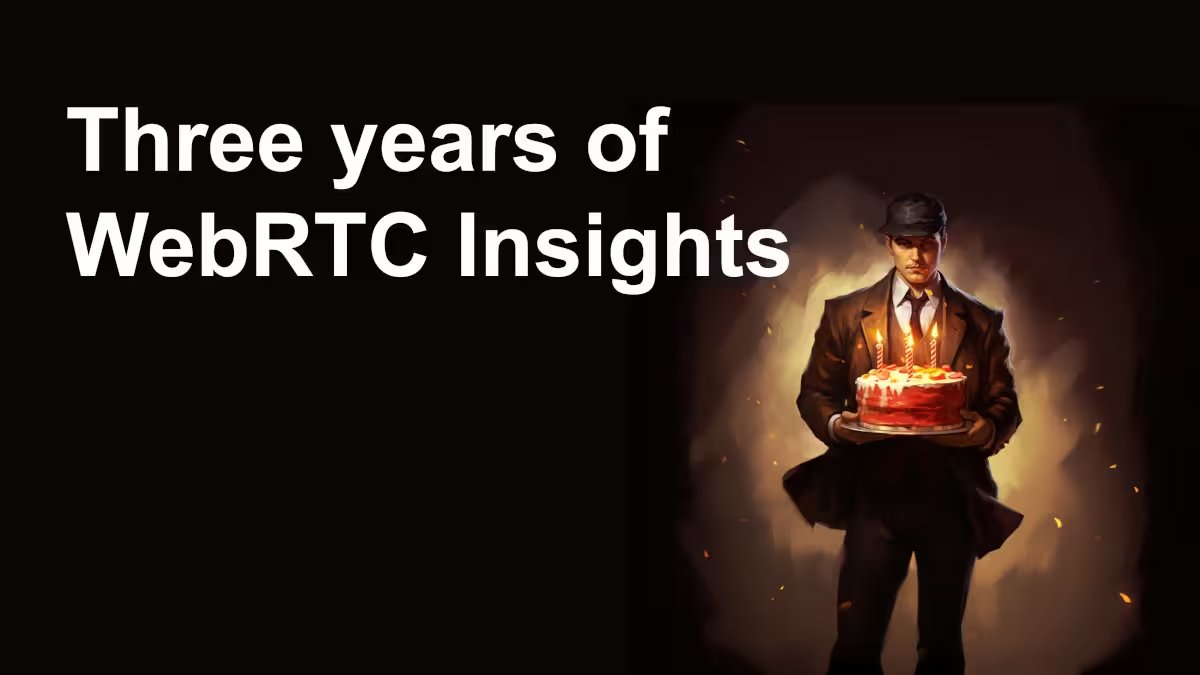
Along with Philipp Hancke, I’ve been running multiple projects. WebRTC Insights is one of the main ones.
Three years ago, we decided to start a service – WebRTC Insights – where we send out an email every two weeks about everything and anything that WebRTC developers need to be aware of. This includes bug reports, upcoming features, Chrome experiments, security issues and market trends.
All of this with the intent of empowering you and letting you focus on what is really important – your application. We take care of giving you the information you need quicker and in a form that is already processed.
Three years into this initiative, this is still going strong. We’ve onboarded a new client recently, and this is what he had to share with us on the first week already:
“[The Insights] Newsletter has been great and very helpful. Wish we had subscribed 2 years ago.”
Sean MacIsaac, Founder and EVP, Engineering @ Roam
😊
Why is the WebRTC Insights so useful for our clients?
It boils down to two main things:
- Time
- Focus
We reduce the time it takes for engineers and product people to figure out issues they face and trends on the market. Instead of them searching the internet to sift through hints or trying to catch threads of information on things they care about, we give it straight to them – usually a few days before their clients (or management) complains about it.
On top of it, we increase their focus on what’s important to them. Going back to past issues to find problems, search issues, look at security problems, know of experiments Google is doing or just be aware of the areas where Google is investing their efforts – all of these become really simple to do.
In the past few weeks we’ve been getting complaints from clients about audio issues on Mac (usually acoustic echo problems in Chrome). These were already hinted to in one of our previous issues and the full details appeared in the more recent issues. In parallel, we’ve been able to sniff around for root causes for them almost in real-time – enabling them to zero in on the problem and find a suitable workaround.
If I weren’t so modest, I would say that for those who are serious about WebRTC, we are a force multiplier in their WebRTC expertise.
WebRTC Insights by the numbers
Since this is the third year, you can also check out our past “year in review” posts:
This is what we’ve done in these 3 years:
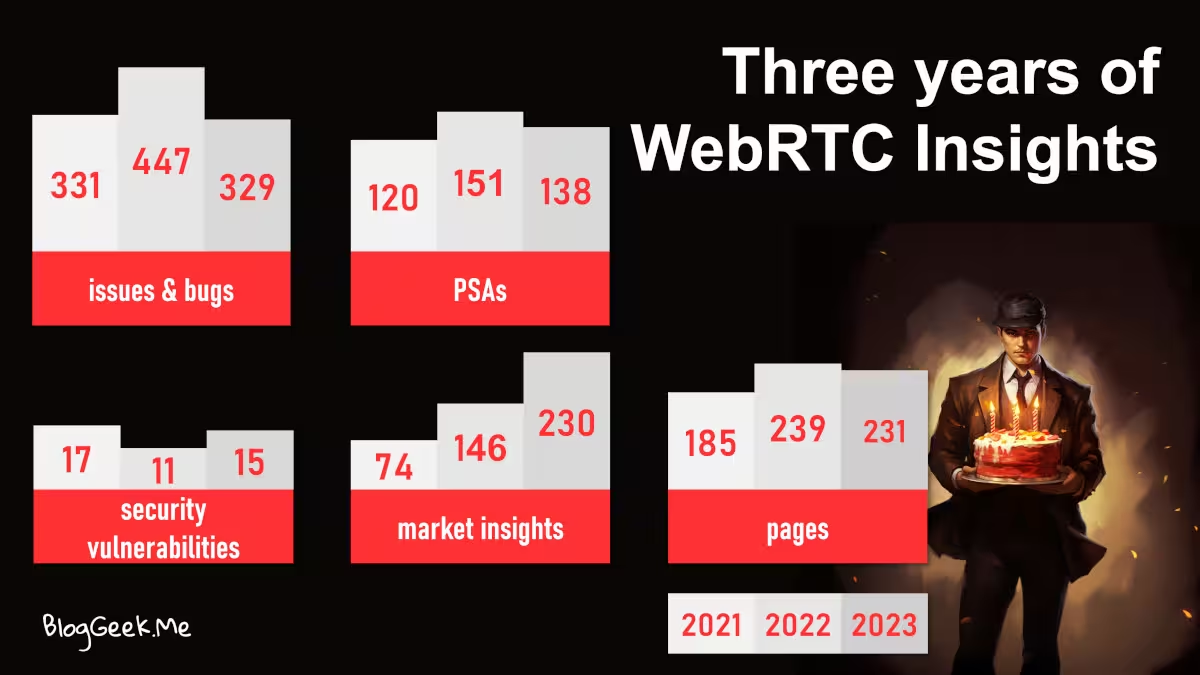
26 Insights issued this year with 329 issues & bugs, 136 PSAs, 15 security vulnerabilities, 230 market insights all totaling 231 pages. That’s quite a few useful insights to digest and act upon.
We have covered over a thousand issues and written more than 650 pages.
👉 WebRTC is still ever changing – both in the codebase and how it gets used by the market.
Activity on libWebRTC has cooled down yet again in the last year, dropping below 200 commits a month consistently:
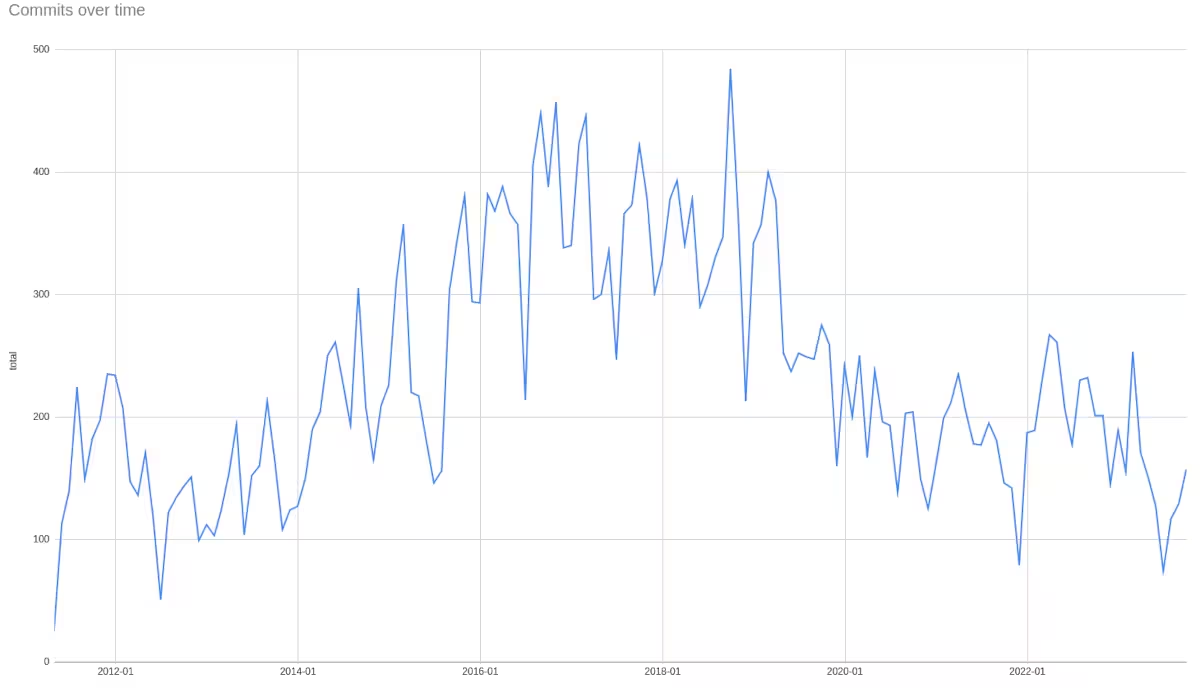
This is more visible by looking at the last four years:
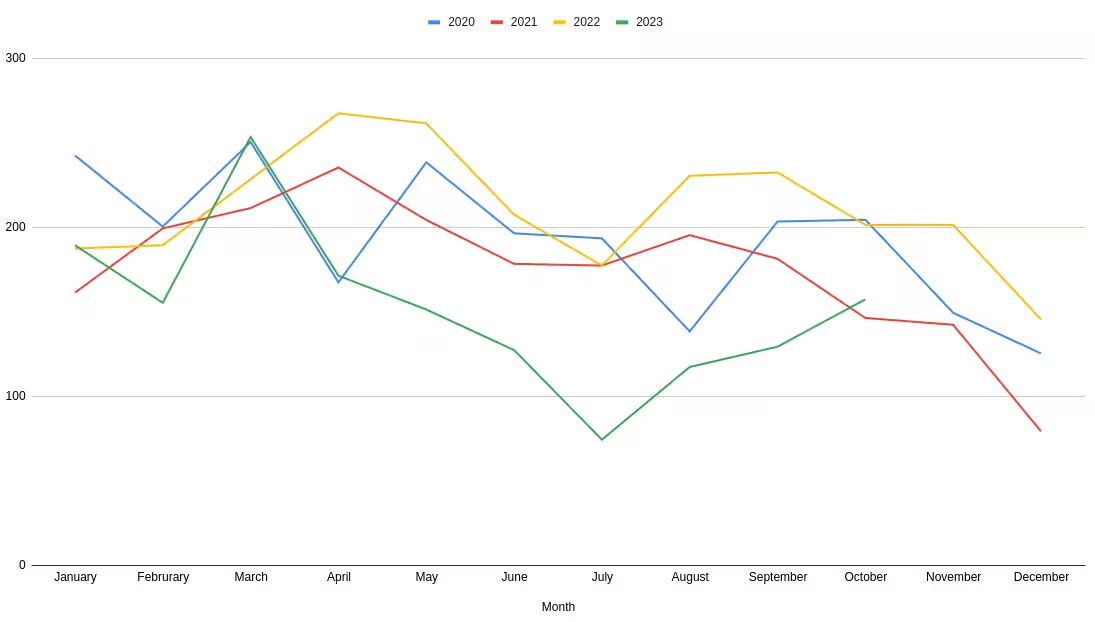
On one hand WebRTC is very mature now, on the other hand it seems to us that there is still a lot of work to be done and bugs to be fixed. External contributions were up. What is concerning is that the “big drop” in May happened three months after Google announced a round of layoffs but we have not seen many departures of long-time contributors.
Let’s dive into the categories, along with a few new initiatives we’ve taken this year as part of our WebRTC Insights service.
Bugs
The number of reported external bugs has dropped considerably as did the number of issues tracking new work and initiatives. This correlates with the decreased commit activity.
The areas for bugs also shifted, we have seen a lot more issues related to hardware acceleration (since Google is eying that now to further reduce the CPU usage in Google Meet). Operating systems are starting to become a bigger issue, for example MacOS Sonoma caused quite a few audio issues and enabled overlaid emoji reactions (a bad choice with consequences described here) by default as part of a bigger push to move features like background blur to the OS layer. And of course, every autumn brings a new Safari on iOS release which means a ton of regressions…
A good example of how Philipp himself uses Insights as a way to identify what change caused a regression was the lack of H.264 fallback on Android which rolled out in Chrome 115 in August. We had been commenting on the original change end of May:

That said, we did not think of Android which remains complicated when it comes to H.264 support. Thankfully this rollout was guarded by a feature flag so the regression could be mitigated by the WebRTC team in less than two days.
PSAs & resources worth reading
In addition to the public service announcements done by Googlers (and Philipp) as part of making changes to the C++ API or network behavior we continue to be tracking Chromium-related “Intents” (which are a useful indicator for what is going to ship) and relevant W3C/IETF discussions in this section. We also moved more in-depth technical comments on relevant blog posts from the “Market” section which made the overall decline in activity less visible here.
Experiments in WebRTC
Chrome’s field trials for WebRTC are a good indicator of what large changes are rolling out which either carry some risk of subtle breaks or need A/B experimentation. Sometimes, those trials may explain behavior that only reproduces on some machines but not on others. We track the information from the chrome://version page over time which gives us a pretty good picture on what is going on:
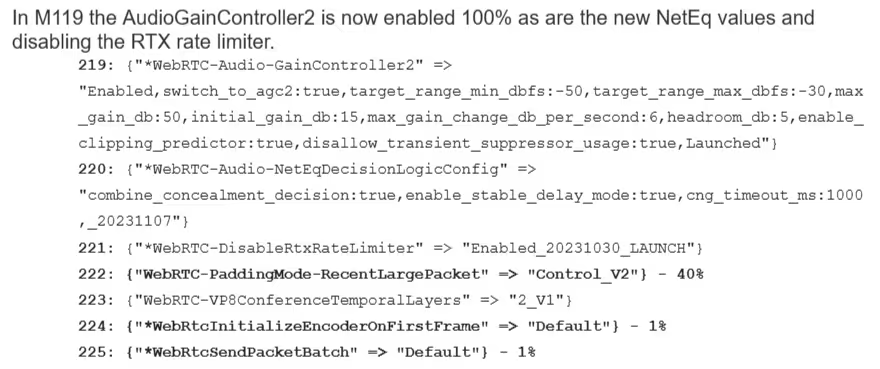
We have gotten a bit better and now track rollout percentages. We have not seen regressions from these rollouts in the last year which is good news.
WebRTC security alerts
This year we continued keeping track of WebRTC related CVEs in Chrome (15 new ones in the past year). For each one, we determine whether they only affect Chromium or when they affect native WebRTC and need to be cherry-picked to your own fork of libwebrtc when you use it that way.
In recent months we’ve seen a trend of looking more closely at the codec implementations to find security threats there. Our expectation is that this will continue in the coming year as well – expect more CVEs around this area.
A personal highlight was Google’s Natalie Silvanovich following up on a silly SDP munging thing Philipp did with CVE-2023-4076 which affected WebRTC munging in Chrome (but not native applications:
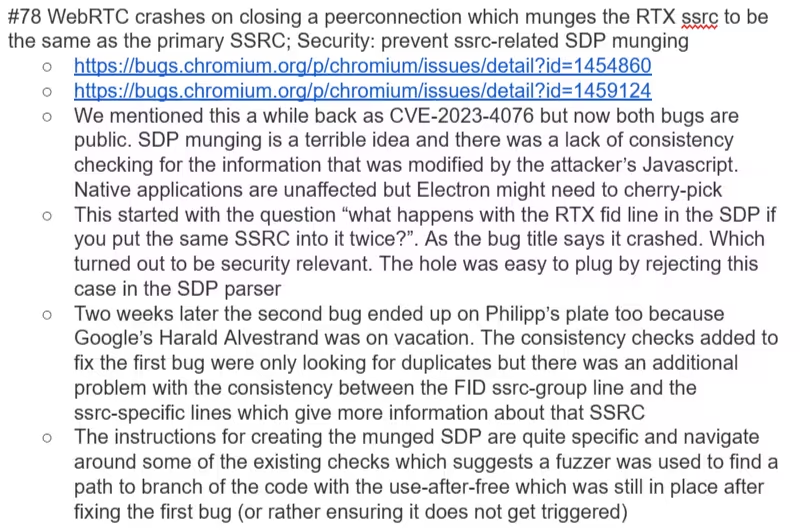
If only anyone had told us that using SDP in the API, let alone having Javascript manipulate it in the input, is a bad idea…
WebRTC market guidance
What are the leaders in video conferencing doing? What is Google doing with Meet, which directly affects WebRTC’s implementation? Are they all headed in the same direction? Do they invest in different technologies and domains?
How about CPaaS vendors? How are they trying to differentiate from each other?
Other vendors who use WebRTC or delve into the communication space – where do they innovate?
Here’s a quick example we’ve noticed when Twilio worked on migrating their media servers to different IP and ports:
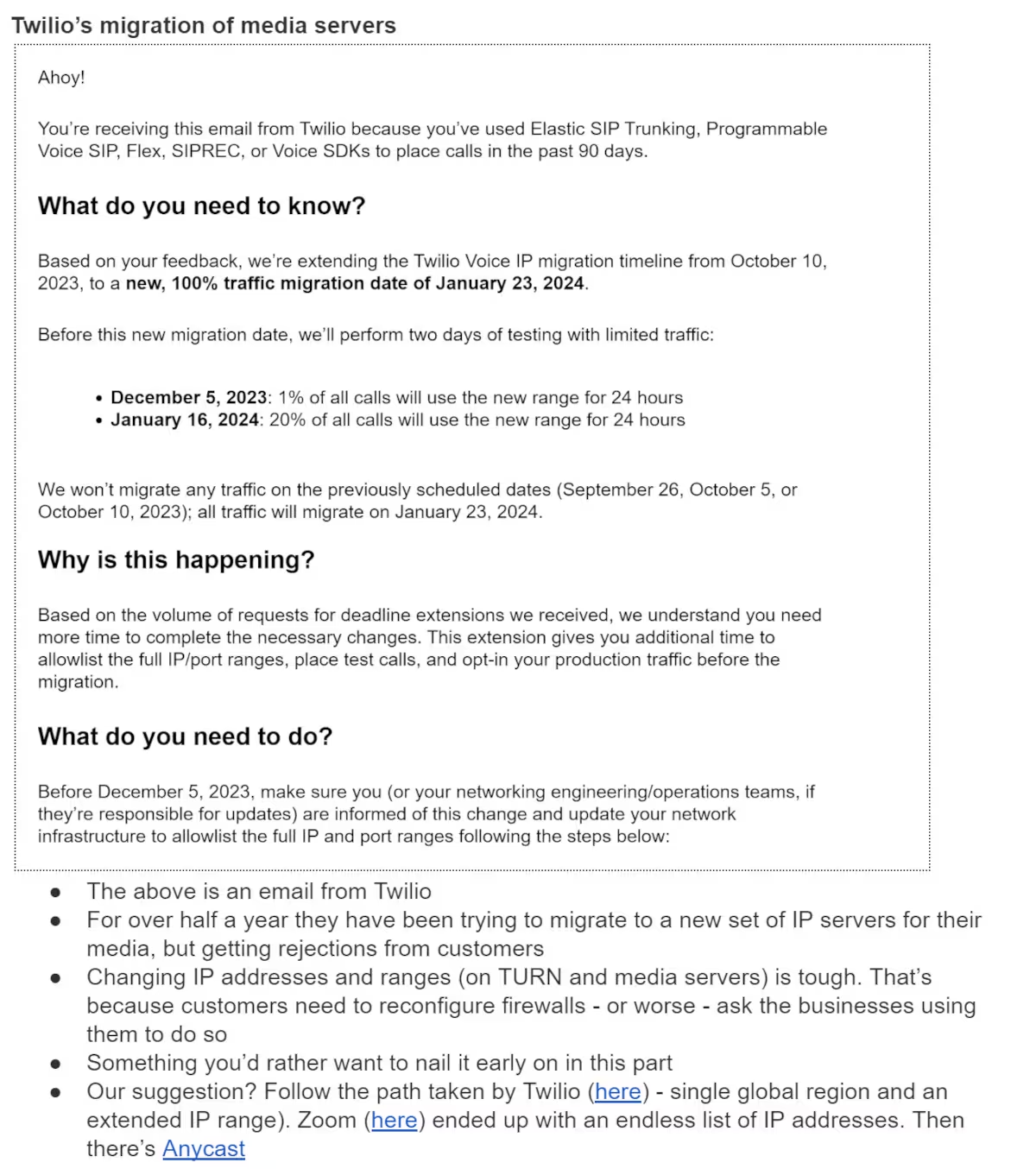
This ability to look at best practices of vendors, how they handled such challenges, or introduced new features is an eye opener. These are the things we cover in our market guidance. The intent here is to get you out of your echochamber that is your own company, and see the bigger world. We do that in small doses, so that it won’t defocus you. But we do it so you can take into account these trends and changes that are shaping our industry.
The interesting thing is that as WebRTC goes more and more into a kind of a “maintenance mode” with its browser releases, the variance and interesting newsworthy items we see on the market as a whole is growing. This is likely why our market insights section has seen rapid growth this year.
Insights automation
We’ve grown nicely in our client base, and up until recently, we sent the emails… manually.
It became a time consuming activity to say the least, and one that was also prone to errors. So we finally automated it.
The WebRTC Issue emails are now automated. They include the specific issue along with the latest collection security issues. It has made life considerably simpler on our end.
Join the WebRTC experts
We are now headed into our fourth year of WebRTC Insights.
Our number of subscribers is growing. If you’ve got to this point, then the only question to ask is why aren’t you already subscribed to the WebRTC Insights if WebRTC interests you so much?
You can read more about the available plans for WebRTC Insights and if you have any questions – just contact Tsahi.
👉 Oh – and you shouldn’t take only our word for how great WebRTC Insights – just see what Google’s own Serge Lachapelle has to say about it:
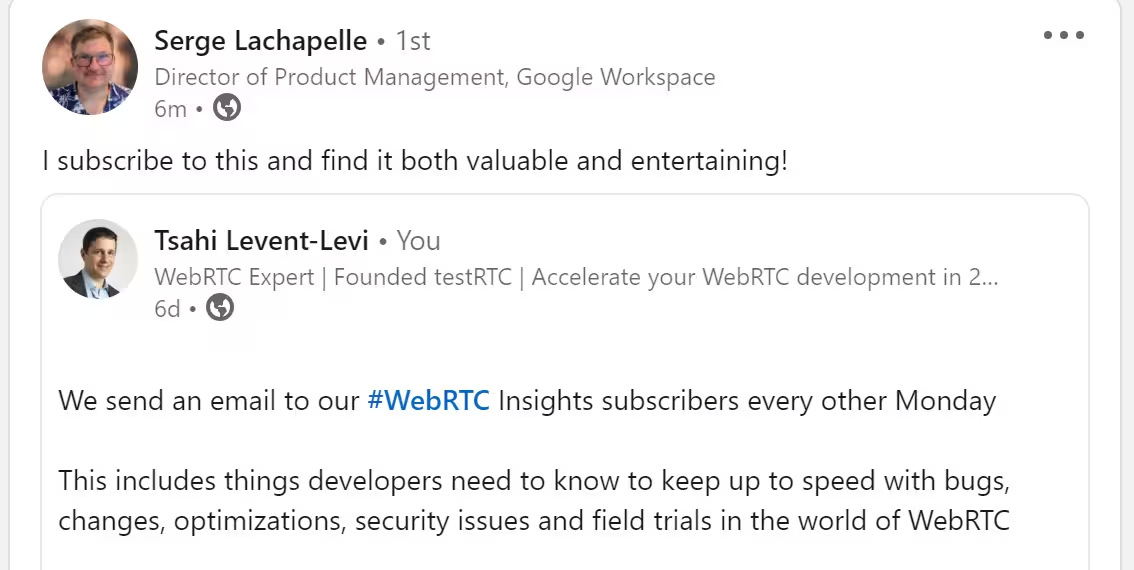
Still not sure? Want to sample an issue? Just reach out to me.
